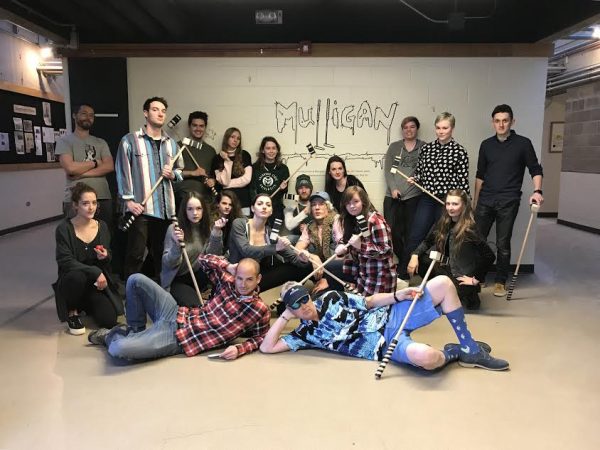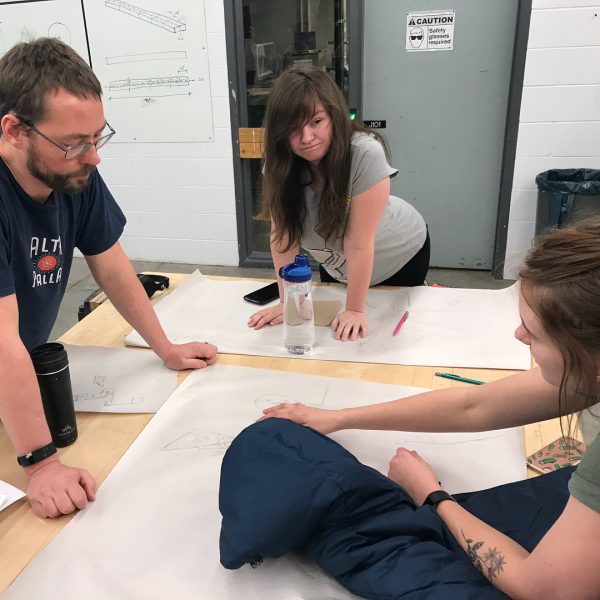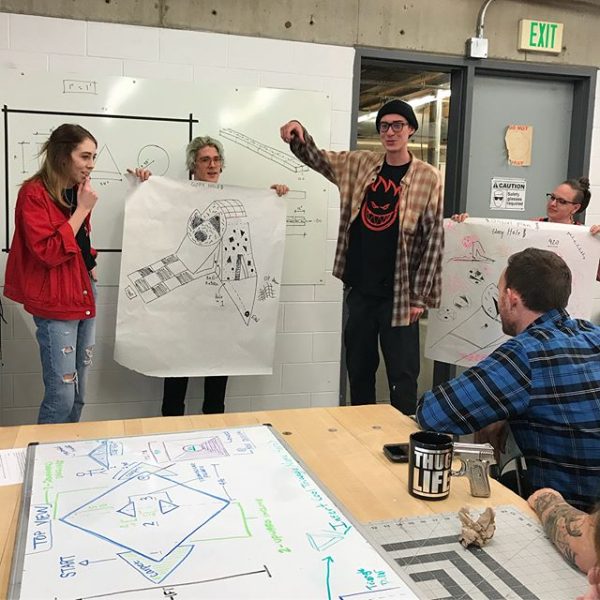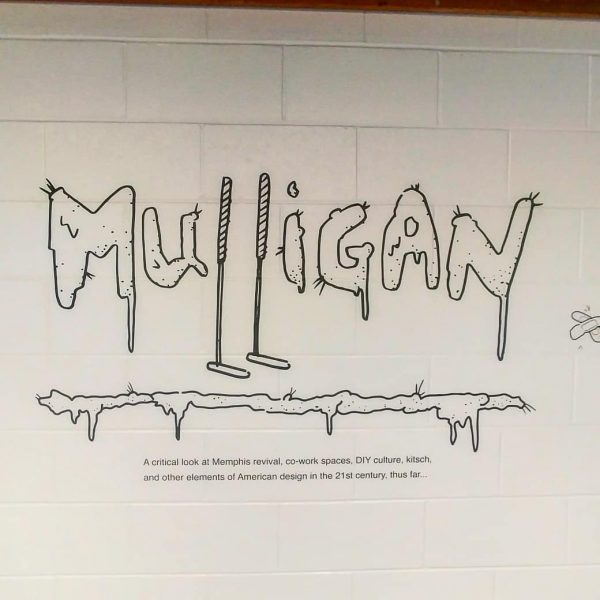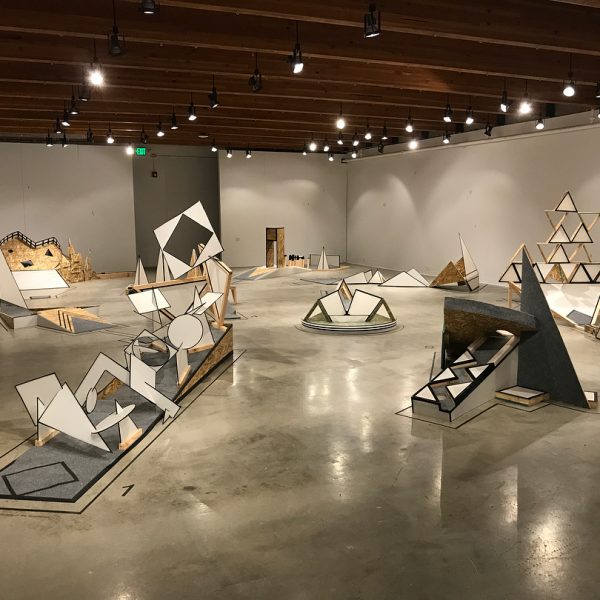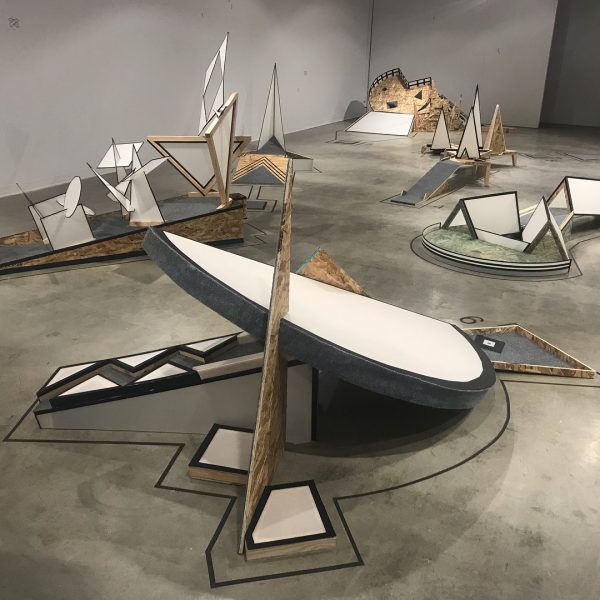Photo by Justin Missner
Art galleries are not usually the place people go to play mini-golf. That is, unless the gallery in question is the Clara Hatton Gallery in the CSU Visual Arts Building.
For the months of January and February 2018, the Hatton Gallery was home to an interactive show called “Mulligan,” a complete nine-hole miniature golf course, put together by CSU art department students and the experimental design studio Zero-Craft Corp.
The collaborative workshop took place over the course of four days in January, and included students from both the graduate and undergraduate programs in the CSU Department of Art and Art History. Nine teams of four, 36 students in total, participated. Each team was led by a graduate student and had limited time and materials to work with. At the workshop’s conclusion, each team had constructed one hole of mini-golf in the gallery. Each design is unique to the team, and what’s better, completely usable.
Zero-Craft Corp. was founded by Michael Neville and Mark Dineen in Detroit in 2015 with the intention of “rejecting the explicit hierarchy of a traditional ‘atelier’ studio and choosing to develop a studio model that is more relational than transactional.” Neville lives in Detroit where he works on his own practice along with Zero-Craft projects. Dineen moved from Detroit to Fort Collins when he took the role of assistant professor of Sculpture and 3D Foundations at CSU in 2016. Dineen and Neville met as students at the Cranbrook Academy of Art in Michigan, where Dineen earned his MFA in 3D Design.
Dineen specializes in 3D foundations, sculpture, and materials literacy, so he is constantly looking for new ways to be experimental with his own three-dimensional design practice. This can include working with abnormal materials like asphalt, or creating everyday items like furniture in a style representative of modern fine arts movements. “I like to work with things that are experimental, conceptual, and can’t easily fit into one box. Especially when working with Zero-Craft, I like to be intentionally evasive,” Dineen said of his work.

Silent video portraying students building sculptures for exhibit.
According to Dineen, Zero-Craft is all about making art about design and design about art. “We also like the collision of high- and low-brow culture, and we are always looking for a way to ‘poke a stick’ at contemporary discourse,” Dineen said. “The mini-golf course checked so many boxes for us. It's a bizarre mash-up of spatial conditions, it’s a low-brow idea, but everyone's done it, and it allowed us to design an experience for the workshop participants that we felt would yield interesting results.”
The idea of working outside the box has been key to the Zero-Craft Corp. operation since the beginning, and the notion of working with a diverse group of people has always been conducive to their vision of the organization. Zero-Craft Corp. has done workshops with college students, fellow artists from all backgrounds, and even a class of third graders.
“Workshops are an important part of how Zero-Craft operates…we like the immediacy and presence that the workshop environment provides. When the Hatton Gallery accepted our proposal for a show, we thought it was the perfect opportunity to engage the students here in the art and art history department in a transdisciplinary way,” Dineen said after the Mulligan workshop.
According to Dineen, Zero-Craft is all about making art about design and design about art. “We also like the collision of high- and low-brow culture, and we are always looking for a way to ‘poke a stick’ at contemporary discourse,” Dineen said. “The mini-golf course checked so many boxes for us. It's a bizarre mash-up of spatial conditions, it’s a low-brow idea, but everyone's done it, and it allowed us to design an experience for the workshop participants that we felt would yield interesting results.”
The idea of working outside the box has been key to the Zero-Craft Corp. operation since the beginning, and the notion of working with a diverse group of people has always been conducive to their vision of the organization. Zero-Craft Corp. has done workshops with college students, fellow artists from all backgrounds, and even a class of third graders.
“Workshops are an important part of how Zero-Craft operates…we like the immediacy and presence that the workshop environment provides. When the Hatton Gallery accepted our proposal for a show, we thought it was the perfect opportunity to engage the students here in the art and art history department in a transdisciplinary way,” Dineen said after the Mulligan workshop.
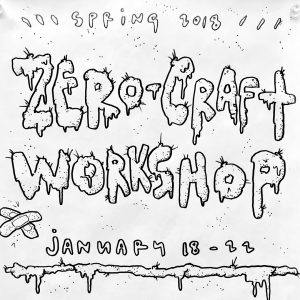
Diversity is an important tenet of the way Zero-Craft Corp. operates. According to Dineen, exploring the experimental element of Zero-Craft projects requires varied perspectives and backgrounds, all on an equal footing of participation. Though all of the participants of the Mulligan workshop were students in the CSU Department of Art and Art History, Neville and Dineen took care to include students from all areas of the department. “By the end of the weekend, you had graduate students hanging out with undergrads, and painters hanging out with metalsmiths. That’s not always something that happens on its own in something like an art department, which is inherently stratified. To see people from all areas of our department hanging out in the workshop was awesome,” Dineen said.
Zero-Craft Corp. is already in the midst of another collaboration, working on bronze sculpture with former chair of the department, Gary Voss. However, the idea of another collaboration with current students is definitely on the table. When it comes to the student involvement on the “Mulligan” project, Dineen said the students exceeded his expectations.
Being met with a miniature golf course in the Hatton Gallery may be surprising to most visitors, but to Dineen the responses from the participants and the department were to be expected. “The biggest surprise wasn't really a surprise at all, but the support and energy we received from the faculty and staff here in the Visual Arts building was almost overwhelming. Everyone who got swept up in our whirlwind was a great sport and contributed something really special.”
